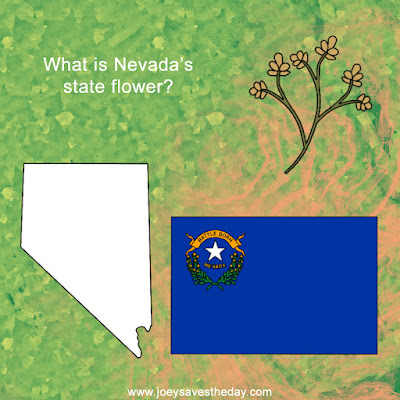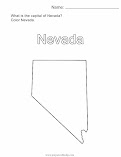Learn facts about Nevada for kids.
Last week, we confidently shared essential facts about... Nebraska. This week, we're excited to share fascinating facts about Nevada! Get ready to learn about the state's flag, its official bird, and many more intriguing details.
Did you know Nevada was the thirty-sixth state to join the United States? During the American Civil War, Nevada officially became a state on October 31, 1864, making it one of the last states to enter the Union in that era. This timing was significant as it helped bolster the Union's political power.
Located in the western region of the United States, Nevada is known for its diverse landscapes, which include vast deserts, mountain ranges, and vibrant cities. The state shares its borders with five other states: Idaho to the north, Utah to the east, Arizona to the southeast, California to the west, and Oregon to the northwest.
Nevada is the seventh-largest state in the country, covering an area of approximately 110,577 square miles. This expansive land area contributes to its classification as one of the larger states in the United States.
According to the most recent estimates, approximately 3,143,991 people reside in Nevada, reflecting a dynamic population influenced by the state's renowned tourism industry, which includes attractions such as Las Vegas and Reno, as well as its breathtaking natural parks, including Lake Tahoe and Red Rock Canyon. The population density varies significantly, with most residents concentrated in urban areas while large portions of the state remain sparsely populated.
Nevada famous person alert:
Calvin Forrest Quate was born in Baker, Nevada. He invented the atomic force microscope and taught Applied Physics and Electrical Engineering at Stanford University.
Make sure to get permission from your parent or caregiver before clicking on any links.
Facts about Nevada:
1. Nevada, located in the western region of the United States, is renowned for its vibrant Las Vegas casinos, which attract millions of visitors each year. These casinos offer various entertainment options, including gaming, fine dining, and live performances, making Las Vegas a premier destination for tourism and nightlife.
In addition to its bustling urban environment, Nevada boasts breathtaking desert landscapes. These include sprawling mountain ranges, unique rock formations, and vast stretches of arid land that are home to various wildlife species. The state's natural beauty includes the iconic Red Rock Canyon and the stunning vistas of Lake Tahoe, which offer opportunities for hiking, skiing, and outdoor recreation.
Historically, Nevada has earned its reputation as the leading gold-producing state in the nation, contributing significantly to the United States' mining industry. This rich mining history has shaped Nevada's economy and culture.
Nevada is often referred to by several nicknames, such as the Battle Born State, which reflects its admission to the Union during the Civil War; the Silver State, a nod to its past as a primary silver mining hub; and the Sagebrush State, which highlights the state's abundant sagebrush vegetation.
The state motto, "Volens et Potens," is a Latin phrase that means "Willing and Able," symbolizing the resilience and determination of its residents. This motto was officially adopted in 1866. For convenience, the abbreviation for Nevada is NV.
2. Carson City serves as the capital of Nevada and has a rich historical background. It officially became the capital in 1864, coinciding with Nevada's statehood. In the western part of the state, Carson City is situated at the base of the Sierra Nevada mountains, providing stunning natural scenery. The city has an estimated population of around 55,244 residents, making it a vibrant community with diverse cultural and recreational offerings. As the political center of Nevada, Carson City is home to several important government buildings and institutions, including the Nevada State Capitol, which reflects the city's historical significance and architectural charm.
3. The state bird of Nevada is the Mountain Bluebird, officially designated on April 4, 1967. This bird is known for its vibrant coloration and striking appearance. The male Mountain Bluebird boasts a brilliant blue plumage that can be easily recognized, complemented by a white underside that adds charm. In contrast, the female Mountain Bluebird is more subdued, featuring a grayish-brown coloration with beautiful blue streaks adorning her wings. These color differences are visually appealing and play a role in the birds' mating behaviors and identification in the wild. The Mountain Bluebird can often be found in open fields and grasslands, where it feeds primarily on insects and berries, making it a delightful sight for nature enthusiasts and bird watchers throughout Nevada.
4. The official state flower of Nevada is the Big sagebrush, scientifically known as Artemisia tridentata, commonly referred to simply as sagebrush. This hardy perennial shrub is well adapted to the region's arid climate and plays a vital role in the local ecosystem. It typically begins to bloom in autumn, producing clusters of small yellow flowers that attract pollinators, including bees and butterflies. The Big Sagebrush is significant for its ecological contributions and holds cultural and historical importance for many indigenous tribes in the area. On March 20, 1917, it was officially designated as Nevada’s state flower, symbolizing the resilience and beauty of the state's natural landscape.
5. Nevada's current state flag was officially adopted on July 1, 1991. The flag is characterized by its striking blue background, representing the sky and the state's vast natural landscapes. The state seal is displayed on the flag, which features a miner and a plow, symbolizing Nevada's rich natural resources and agricultural heritage. Surrounding the state seal is a wreath of laurel leaves, signifying victory and honor. The flag reflects Nevada's history and identity, serving as a proud emblem for its residents.
6. Nevada is known for its diverse agricultural output, with various crops that thrive in its unique climate. Among them are alfalfa seed, primarily used for livestock feed; garlic, prized for its flavor and health benefits; hay, harvested for animal fodder; potatoes, cultivated for their versatility in cooking; and wheat, an essential grain used in many food products. These crops contribute significantly to the state's agricultural economy and reflect Nevada's adaptability to farming practices.
7. Nevada offers a variety of fascinating destinations for visitors to explore. One of the most iconic landmarks is the Hoover Dam, located in Clark County. This engineering marvel, built during the Great Depression, provides stunning views of the Colorado River and Lake Mead and opportunities for guided tours that explain its history and significance.
Another must-visit spot is Lake Tahoe, a breathtaking alpine lake that straddles the California-Nevada border. Known for its crystal-clear waters and picturesque mountain scenery, Lake Tahoe is a year-round destination offering hiking, skiing, and water sports activities. Don’t forget to explore the charming lakeside towns and enjoy the stunning sunsets.
Additionally, the Fly Ranch Geyser in Washoe County is a unique natural phenomenon worth visiting. This colorful geyser, formed by geothermal activity, displays vibrant hues and interesting formations. It’s located near the Fly Ranch property, part of the Black Rock Desert. Remember to check access restrictions and possible tour options, as it is not always open to the public.
These destinations highlight the diverse beauty and intriguing history that Nevada has to offer.
8. Nevada is home to diverse wildlife, showcasing the state's unique ecosystems. Among its notable inhabitants are the majestic bighorn sheep, known for their impressive curved horns and agility in rocky terrains. Bears, including black and grizzly species, roam the mountainous areas, while coyotes, adept at adapting to various habitats, are commonly seen throughout the state.
Elk can be found grazing in the lush meadows, especially in the northern regions, and mule deer, with their distinctive large ears and robust build, traverse both forested and desert landscapes. The arid environment is also home to scorpions, which thrive in the state's warm climate. Lastly, wolves have made a comeback in certain parts of Nevada, playing a crucial role in maintaining the ecological balance. Together, these animals contribute to the rich biodiversity that Nevada has to offer.
9. Nevada experiences a wide range of temperatures throughout the year, with extremes that can be pretty surprising. The highest temperature recorded in the state was 125 degrees Fahrenheit, reached in Laughlin on June 29, 1994. Conversely, the coldest temperature recorded in Nevada was -50 degrees Fahrenheit (50 degrees below zero) in San Jacinto on January 8, 1937.
Get your free printable Nevada worksheet here:
🎰 Nevada – Compare Desert and City Life – ACTIVITY
Let’s explore Nevada!
Nevada has deserts and bright cities like Las Vegas—two very different worlds!
Activity Steps:
1. Draw two circles for a Venn diagram.
2. In one circle, list things you’d find in the desert.
3. In the other, list things you’d find in a busy city.
4. In the middle, write what both places have in common.
Reflection:
Do you feel more peaceful in quiet places or excited in busy ones?
Books about Nevada:
1. S is for Silver: A Nevada Alphabet by Eleanor Coerr
2. What's Great about Nevada? by Rebecca Felix
3. Nevada History Projects - 30 Cool Activities by Carole
Marsh
4. My First Book About Nevada! by Carole Marsh
Parents/caretakers, be sure books are child-friendly before
reading them to your child/children.
You can Click here to purchase the 50 States workbook on Amazon.
Utilize the 50 States Hub tab at the top of my page to effortlessly access posts about all 50 states in one convenient location. It's your go-to resource for exploring every state!
Be sure to tune in next week to discover some fascinating facts about... New Hampshire! Thank you for reading my post!!









Cool did not know all these facts about Nevada.
ReplyDeleteThank you! I hope you enjoyed.
Delete